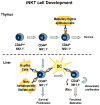Regulating the immune system via IL-15 transpresentation
- PMID: 22795955
- PMCID: PMC3422378
- DOI: 10.1016/j.cyto.2012.06.017
Regulating the immune system via IL-15 transpresentation
Abstract
Transpresentation has emerged as an important mechanism mediating IL-15 responses in a subset of lymphocytes during the steady state. In transpresentation, cell surface IL-15, bound to IL-15Rα is delivered to opposing lymphocytes during a cell-cell interaction. The events most dependent on IL-15 include the development and homeostasis of memory CD8 T cells, Natural Killer cells, invariant Natural Killer T cells, and intraepithelial lymphocytes. As lymphocyte development and homeostasis involve multiple steps and mechanisms, IL-15 transpresentation can have diverse roles throughout. Moreover, distinct stages of lymphocyte differentiation require IL-15 transpresented by different cells, which include both hematopoietic and non-hematopoietic cell types. Herein, we will describe the points where IL-15 transpresentation impacts these processes, the specific cells thought to drive IL-15 responses, as well as their role in the course of development and homeostasis.
Copyright © 2012 Elsevier Ltd. All rights reserved.
Figures



Similar articles
-
Dendritic cells drive memory CD8 T-cell homeostasis via IL-15 transpresentation.Blood. 2008 Dec 1;112(12):4546-54. doi: 10.1182/blood-2008-05-156307. Epub 2008 Sep 23. Blood. 2008. PMID: 18812469 Free PMC article.
-
IL-15 transpresentation augments CD8+ T cell activation and is required for optimal recall responses by central memory CD8+ T cells.J Immunol. 2008 Apr 1;180(7):4391-401. doi: 10.4049/jimmunol.180.7.4391. J Immunol. 2008. PMID: 18354159
-
IL-15 transpresentation promotes both human T-cell reconstitution and T-cell-dependent antibody responses in vivo.Proc Natl Acad Sci U S A. 2011 Apr 12;108(15):6217-22. doi: 10.1073/pnas.1019167108. Epub 2011 Mar 28. Proc Natl Acad Sci U S A. 2011. PMID: 21444793 Free PMC article.
-
IL-15 receptor alpha as the magic wand to boost the success of IL-15 antitumor therapies: The upswing of IL-15 transpresentation.Pharmacol Ther. 2017 Feb;170:73-79. doi: 10.1016/j.pharmthera.2016.10.012. Epub 2016 Oct 21. Pharmacol Ther. 2017. PMID: 27777088 Review.
-
Control of memory CD8+ T cell longevity and effector functions by IL-15.Mol Immunol. 2020 Jan;117:180-188. doi: 10.1016/j.molimm.2019.11.011. Epub 2019 Dec 6. Mol Immunol. 2020. PMID: 31816491 Free PMC article. Review.
Cited by
-
Novel Drug Therapeutics in Celiac Disease: A Pipeline Review.Drugs. 2022 Oct;82(15):1515-1526. doi: 10.1007/s40265-022-01784-2. Epub 2022 Oct 17. Drugs. 2022. PMID: 36251239 Review.
-
Interleukin-15 suppresses gastric cancer liver metastases by enhancing natural killer cell activity in a murine model.Oncol Lett. 2018 Oct;16(4):4839-4846. doi: 10.3892/ol.2018.9303. Epub 2018 Aug 14. Oncol Lett. 2018. PMID: 30250549 Free PMC article.
-
Drug-Induced Severe Cutaneous Adverse Reactions: Insights Into Clinical Presentation, Immunopathogenesis, Diagnostic Methods, Treatment, and Pharmacogenomics.Front Pharmacol. 2022 Apr 20;13:832048. doi: 10.3389/fphar.2022.832048. eCollection 2022. Front Pharmacol. 2022. PMID: 35517811 Free PMC article. Review.
-
Transcriptional regulation of IL-15 expression during hematopoiesis.J Immunol. 2013 Sep 15;191(6):3017-24. doi: 10.4049/jimmunol.1301389. Epub 2013 Aug 21. J Immunol. 2013. PMID: 23966624 Free PMC article.
-
The expression levels of CHI3L1 and IL15Rα correlate with TGM2 in duodenum biopsies of patients with celiac disease.Inflamm Res. 2020 Sep;69(9):925-935. doi: 10.1007/s00011-020-01371-9. Epub 2020 Jun 4. Inflamm Res. 2020. PMID: 32500186
References
-
- Bamford RN, Grant AJ, Burton JD, Peters C, Kurys G, Goldman CK, et al. The interleukin (IL) 2 receptor beta chain is shared by IL-2 and a cytokine, provisionally designated IL-T, that stimulates T-cell proliferation and the induction of lymphokine-activated killer cells. Proc Natl Acad Sci U S A. 1994;91:4940–4. - PMC - PubMed
-
- Grabstein KH, Eisenman J, Shanebeck K, Rauch C, Srinivasan S, Fung V, et al. Cloning of a T cell growth factor that interacts with the beta chain of the interleukin-2 receptor. Science. 1994;264:965–8. - PubMed
-
- Giri JG, Anderson DM, Kumaki S, Park LS, Grabstein KH, Cosman D. IL-15, a novel T cell growth factor that shares activities and receptor components with IL-2. J Leukoc Biol. 1995;57:763–6. - PubMed
-
- Kallies A, Xin A, Belz GT, Nutt SL. Blimp-1 transcription factor is required for the differentiation of effector CD8(+) T cells and memory responses. Immunity. 2009;31:283–95. - PubMed
Publication types
MeSH terms
Substances
Grants and funding
LinkOut - more resources
Full Text Sources
Other Literature Sources
Medical
Research Materials

